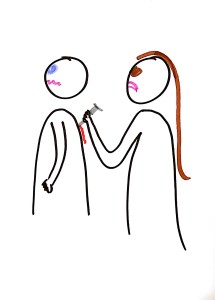 3 steps to productivity and engagement
3 steps to productivity and engagement
“Graham, I’d like to talk with you about how I’ve been unintentionally sabotaging your work as transformation CEO,” said T. on day 3 of our strategy meeting.
How often was this the conversation that I’ve needed; that you’ve needed; and that we all too seldom have? Instead someone is blamed, trained or fired. If a square peg is in a round hole, ask yourself whether round is the only possible hole before you change the peg.
You are losing productivity if you fail to make it safe to have these conversations.
Three things make conversations like this common in edgetalents, Dojo4Life etc. possible.
- Commitment to excellence in business and individual development outcomes with no compromise between them.
- We make it safe to go to the vulnerable edge of each person’s potential.
- We keep everyone working from their best selves.
We became an organisation where everybody said “thank God it’s Monday.”
The magic enabling such a conversation is often sought only in the personal integrity of the individuals. High as her integrity and my integrity is, it is never enough. You also need organisational integrity (structural and process integrity, like a bridge.) Structures and mutually agreed ways of interacting that make it safe to perform on your edge. (We used Holacracy(1) and crowdcoaching from Dojo4Life(2).)
Then you get a virtuous circle. Every action between staff increases their personal integrity. Which increases the organisational integrity.
T and I knew that both of us and the rest of the team would support of each of us revealing our vulnerabilities. The things we need to protect to be able to work in the organisation as it is. Those vulnerabilities that trigger inner voices of blame, shame and fear.
Fear of blame and shame hold almost all businesses back from peak productivity(3). It is up to the organisation to create a safe work environment. Then individuals increase their productivity immediately.
T knew that we would welcome what she was saying. Knew that the only use that would be made of our dialogue would be to inform how we should shape the organisation. Not to blame or shame her. Or me.
How, you may be asking. Isn’t this unrealistic, you may be asking. No.
Doing this is the reason organisations were invented. An organisation is just another tool Homo Sapiens uses. A tool to do the job of enabling a large number of people to collaborate in producing more or bigger than any one of us could do alone.
A tool enabling each individual to be better than they could otherwise be. That’s how we designed edgetalent. It’s how we have designed Dojo4Life. How well does your organisation enable you be better than you could otherwise be?
“I am my best self when we’re working together.” – Dojo4Life colleague
Very few organisations are good enough tools for productivity in today’s world. Designed to shape the holes to get the most out of all the pegs. How much is wasted hiring and firing a succession of talented people that don’t quite fit the hole they are “pegged” into?
Yet with agile / Teal organisation designs it is easy to change the organisation and get immediate productivity gains.
Of course there is always a need for some change of the individual too.
Organisations that work this way deliver, paradoxically, better business results (4).
Do you want to succeed now and long-term? The following three stage process eliminates friction and adds fuel.
- Flow: Keep people in flow. Match individual’s dispositions and competencies to roles and tasks requiring those dispositions and competencies (5).
- Development: Individual development a no-compromise objective. Use tools to do so in every interaction: peer to peer coaching (e.g. Dojo4Life(2)) and developmental coaching of the executives (IDM(6)).
- Organise for Flow and Development: Maximise productivity of the whole organisation by maximising productivity of all individuals. Use agile designs and processes, such as Holacracy, Sociocracy3.0 etc.
You can begin implementing stages 1 and 2 now. Whatever level you are in your organisation. You can even begin using elements of stage 3. Contact me if you want help implementing these stages.
And if you want to go to the ultimate level, use a requisite organisation method to fill roles. Also structure your company using e.g. Fair Shares model articles of Rory Ridley-Duff and other multi-stakeholder approaches(7).
Further Reading
- Holacracy (http://www.holacracy.org/) or Sociocracy 3.0 (http://sociocracy30.org/)
- Dojo4Life: http://dojo4life.com/ and https://www.facebook.com/dojo4life/, sign up on our mailing list: http://eepurl.com/bvrqez
- Brene Brown: See here: http://brenebrown.com/ and especially watch her TED talks.
- Robert Kegan and Lisa Lahey, “Making Business Personal” HBR: https://hbr.org/2014/04/making-business-personal
- Peter Drucker, “The Effective Executive” chapter 4, Making Strength Productive and Mihaly Csikszentmihalyi: “Flow, the secret to happiness”
- IDM – Interdevelopmental Institute, Otto Laske. http://interdevelopmentals.org/
- “Requisite Organisation” by Elliot Jaques and IDM in (6)
Fair Shares: http://www.fairshares-association.com/ and https://www.linkedin.com/pulse/multistakeholder-voting-way-companies-thrive-graham-boyd